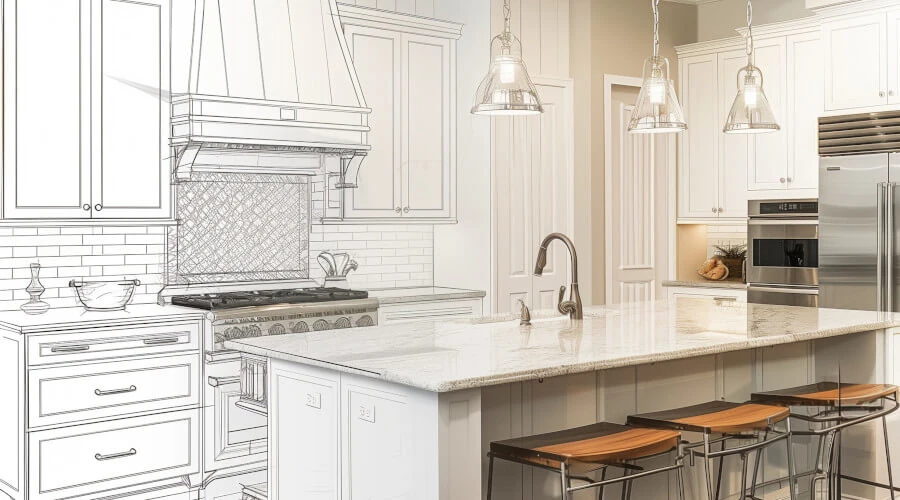Cleaning kitchen cabinets is more than just a matter of good housekeeping. It’s a crucial step in maintaining the functionality and appeal of one of your home’s most significant investments. Grimy fingerprints, cooking grease, and everyday dust and debris are going to find your cabinets. Having a clear and detailed plan for cleaning your kitchen cabinets is essential. This guide on how to clean kitchen cabinets offers thorough instructions on the best way to clean cabinets, how often to clean them, what tools and cleaners to use, and how to keep your cabinets looking their best.
Why Regular Cleaning is Important
Kitchen cabinets are exposed to various contaminants, from cooking oils to sticky fingers. Over time, this can not only make them look dirty but can also lead to damage. The buildup of grease and dirt can damage the finish of your cabinets and hardware. Regular cleaning will keep your cabinets looking their best. Clean cabinets also contribute to a healthier kitchen environment.
How Often Should I Clean?
Cleaning kitchen cabinets shouldn’t take a lot of time. The best way to clean cabinets is with a regular routine. Keep your cabinets in top shape with a quick and easy daily, weekly, and seasonal cleaning routine.
Daily Maintenance
You don’t need to wipe down your cabinets every day. But you should take care of splatters and spills ASAP. Fresh spills and splatters are easier to clean. Most can be cleaned with a damp cloth. A gentle multipurpose cleaner sprayed on a paper towel should work for more persistent stains.
Weekly Cleaning
Once a week, devote some time to cleaning the cabinet surfaces more thoroughly. This helps address any buildup before it becomes too hard to remove and keeps your cabinets looking fresh. Your cabinets don’t need a complete cleaning. Spot-cleaning water spots, fingerprints, and other dirt should be enough.
Seasonal Deep Cleaning
Deep cleaning kitchen cabinets three or four times a year is a good practice. Clean the inside of the cabinets, organize the contents, and address any stains or areas needing special attention.
Essential Cleaning Supplies
The best way to clean cabinets starts with choosing the right tools. Here’s what you’ll need:
Microfiber cloths: Effective in trapping dust and grime without scratching the finishes.
Mild dish soap: A universal cleaner that’s safe for most cabinet surfaces. Dish detergents, like Dawn, are a great choice for cleaning kitchen cabinets. They’re designed to cut through grease, but mild enough to avoid damaging your RTA cabinets.
Baking soda: Ideal for making a cleaning paste for tough stains.
White vinegar: Excellent for cutting through grease; remember to dilute it with water.
Commercial wood cleaner: a mild, non-abrasive wood cleaner, like Murphy’s Oil Soap, is another option for wood cabinets.
Soft sponge or brush: Useful for scrubbing away residues without causing scratches.
Step-by-Step Cleaning Process
1. Preparation: Mix a small amount of dish soap with warm water in a bucket. This should be strong enough for most jobs. For more challenging stains, prepare a paste of baking soda and water. White vinegar diluted with water makes a stronger natural grease-fighting cleaner.
2. Surface Cleaning: Dip a microfiber cloth into the soapy water, wring it out well, and wipe down the exterior of the cabinets. Use a soft-bristled brush to reach into crevices and detailed moldings.
3. Stain Removal: Apply the baking soda paste or vinegar solution directly to greasy or heavily soiled spots. Let it sit for a few minutes to break down the grease, then wipe clean with a damp cloth.
4. Drying: Immediately dry all surfaces with a clean, dry microfiber cloth to prevent any water

See Your Dream Kitchen Come to Life
Free Kitchen DesignTailored Approaches for Different Finishes
The best way to clean cabinets depends on the material and finish of the cabinet.
Painted Cabinets: Use a gentle, non-abrasive cleaner like diluted dish soap to avoid damaging the paint.
Wood Cabinets: A commercial wood cleaner or a mild soapy solution works well, but avoid soaking the wood with too much moisture.
Laminate Cabinets: These can handle a bit more moisture, so a vinegar solution or a stronger degreaser can be used for tougher stains.
Glass Panels: Use a glass cleaner or a solution of vinegar and water. To avoid damaging the finish, spray it onto a lint-free cloth instead of directly on the glass.
Pro Tips for Impeccable Cabinets
Test First: Always test any cleaner on a small, inconspicuous area of your cabinetry to ensure it doesn’t cause damage.
Hardware and Fixtures: Don’t forget to clean handles and knobs. These can often be the grimiest parts, as they are touched frequently.
Use a Degreaser: Consider a commercial degreaser if you have a significant grease buildup. The cabinets next to and above your range usually collect the most grease and may need extra attention.
Vacuum the Interiors: When it’s time for a deep cleaning, use a vacuum with a brush attachment to remove dust and crumbs from inside your cabinets.
Don’t Use Your Dish Rag or Sponge: It’s probably within easy reach on your counter. But it may contain grease remnants. Use a clean cloth or sponge.
Tackling Tough Stains and Grease
For built-up grease and grime, a stronger approach might be needed. Mix baking soda with a bit of water to form a paste and gently scrub the affected areas. For stubborn food splatters and watermarks, specialized wood cleaning products can be very helpful. Remember to follow the product instructions carefully.
Polishing and Protecting Wood Cabinets
Polishing your wood cabinets makes them shine and also adds a protective layer. Look for eco-friendly and chemical-free polishes to keep your kitchen environment healthy. Apply the polish following the grain of the wood for the best results, and buff to a shine with a soft cloth.
Do’s and Don’ts of Cleaning Kitchen Cabinets
Do
- Dust regularly
- Clean up spills immediately
- Use gentle cleaning solutions
Don’t
- Use abrasive cleaners
- Soak the wood
- Use cleaning products that contain bleach or ammonia
Our RTA Kitchen Cabinets
At Cabinets Door to Door, all of our RTA Kitchen cabinets are finished with premium quality finishes from Sherwin Williams. These finishes are chosen not just for their appearance, but also for their durability. With a little maintenance, your ready to assemble cabinets will look like new for years to come.
In addition to premium finishes, all of our RTA kitchen cabinets feature concealed soft-close under-drawer glides, soft-close, 6-way adjustable, concealed hinges, solid hardwood face frames, solid hardwood dovetail drawers, and all plywood cabinet boxes.
Get Your Dream Kitchen Today!
Shop RTA Kitchen CabinetsWhether you have RTA kitchen cabinets or custom cabinets, knowing how to clean kitchen cabinets is essential for preserving their beauty and functionality. Cleaning kitchen cabinets doesn’t need to be a daunting task.
Incorporate daily, weekly, and seasonal cleaning routines to keep your cabinets looking new. Choose the right cleaning supplies and methods to ensure effective and safe cleaning. Regular attention to stains, grease, and dust will extend the life of your cabinets and keep your kitchen environment healthy. Follow the steps and tips outlined in this guide to enjoy pristine, long-lasting cabinets and keep your kitchen looking fresh.
Happy Cleaning!
FAQs
How can I make my cabinets shine?
The first step to making your cabinets shine is regular cleaning. Polishing your cabinets with a commercial wood polish will give you a deeper shine and an added layer of protection. When choosing a polish, look for products labeled silicone-free. Silicone-based polishes build up over time, creating a hazy and tacky layer on the outside of the cabinets.
Do I need to deep clean cabinets seasonally?
We recommend deep cleaning your cabinets seasonally (three to four times a year). Even if you immediately clean up spills and splatters and spot-clean your cabinets, you will likely miss some areas. Cabinet interiors rarely get cleaned out and the tops of cabinets can be difficult to reach. A thorough seasonal cleaning ensures your cabinets will last a lifetime and always look their best.
How much Dawn do I use to clean kitchen cabinets?
One tablespoon of Dawn dish detergent to one gallon of water is a good baseline for mixing your own cleaning solution. But the ratio is very forgiving. It doesn’t take a lot of dish detergent to penetrate the dirt and grease on your cabinets. If your cabinets aren’t getting clean, increase the amount of detergent. If you notice a haze or sticky residue after cleaning, decrease the amount of detergent.
How to clean modular kitchen cabinets?
The process of cleaning modular kitchen cabinets and custom cabinets is the same. Wipe up spills immediately and clean them regularly with a gentle cleanser. Plan a seasonal deep cleaning to take care of the interiors and harder-to-reach spots.

